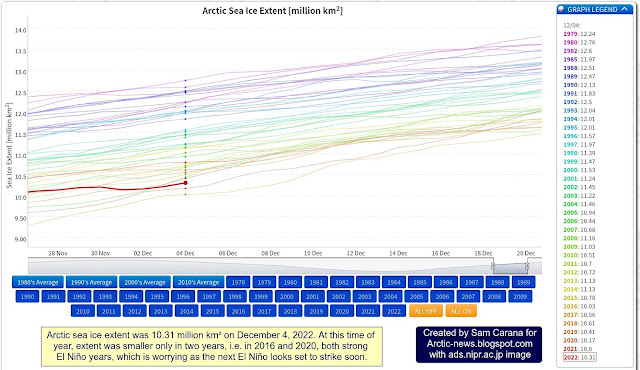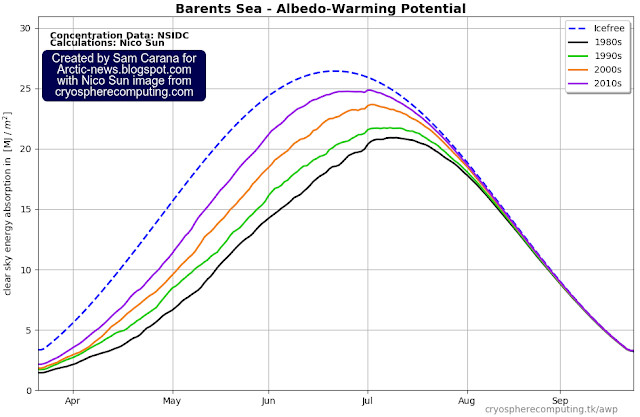This record high sea surface temperature comes as we're moving into an El Niño, as illustrated by the image on the right, adapted from NOAA.
Moving from the bottom of a La Niña to the peak of a strong El Niño could make a difference of more than half a degree Celsius, as illustrated by the image below, adapted from NOAA.
Even more dangerous than high global sea surface temperatures are sea surface temperatures in the North Atlantic, which have been at a record high for the time of year for some time, climbing to well above 20°C on March 29, 2023, as illustrated by the image below.
Vast amounts of heat moves from the North Atlantic into the Arctic. Around this time of year, North Atlantic sea surface temperatures are at their annual low, in line with changes in the seasons. Last year, North Atlantic sea surface temperatures reached a record high of 24.9°C in early September.
On March 15, 2023, sea surface temperatures off the east coast of North America were as much as 13.8°C or 24.8°F higher than 1981-2011, as illustrated by the above image. Sea surface temperature anomalies are also high in the Pacific, reflecting an upcoming El Niño. All this spells bad news for Arctic sea ice, which typically reaches its lowest extent in September.
The above Argo float compilation image illustrates the danger that a cold freshwater lid is forming on top of the North Atlantic.
 |
| [ Cold freshwater lid on North Atlantic (2020) ] |
Stronger winds along the path of the Gulf Stream can at times speed up sea currents that travel underneath this cold freshwater lid over the North Atlantic. As a result, huge amounts of warm, salty water can travel from the Atlantic Ocean toward the Arctic Ocean, abruptly pushing up temperatures and salinity levels at the bottom of the Arctic Ocean.
The above Argo float image illustrates the danger that heat can reach the seafloor. North of Norway, where the water is less than 400 m deep, temperatures higher than 5°C show up throughout the vertical water column, over a period from May 31, 2022, to March 16, 2023.
The panel on the left of the above image, from an earlier post, shows sea surface temperatures on June 20, 2020, while the panel on the right shows a bathymetry map indicating that the sea in a large part of the Arctic Ocean is very shallow.
The above map shows the thickness of Northern Hemisphere permafrost on land and below the seabed.
The above image describes how methane can escape from the permafrost and the seafloor of the Arctic Ocean.
The danger of destabilization of methane hydrates is especially large where methane is present in submarine permafrost and seas are shallow, such as the East Siberian Arctic Shelf (ESAS, see image below).
The above image was created with content from a paper by Natalia Shakhova et al., from an earlier post.
 |
| [ click on images to enlarge ] |
As illustrated by above compilation image, both the volume and extent of Arctic sea ice are low for the time of year.
With further melting of sea ice and thawing of permafrost, the Arctic Ocean can be expected to receive more heat over the next few years, more heat from direct sunlight, more heat from rivers, more heat from heatwaves and more ocean heat from the Atlantic Ocean and the Pacific Ocean.
The above image illustrates the danger of two tipping points getting crossed, i.e. the Latent Heat Tipping Point and the Seafloor Methane Tipping Point, resulting in rapid destabilization of methane hydrates at the seafloor of the Arctic Ocean leading to explosive eruptions of methane, as its volume increases 160 to 180-fold when leaving the hydrates.
 |
| Latent heat loss, feedback #14 on the Feedbacks page |
Climate Emergency Declaration
A catastrophe of unimaginable proportions is unfolding. Life is disappearing from Earth and runaway heating could destroy all life. At 5°C heating, most life on Earth will have disappeared. When looking only at near-term human extinction, 3°C will likely suffice.
Meanwhile, current laws punish people for the most trivial things, while leaving the largest crime one can imagine unpunished: planetary omnicide!
Considering this, a Climate Emergency should be declared, supporting action including:
- Institutionalization of climate deniers until rehabilitated, under national acts such as the U.S. RICO (Racketeer Influenced and Corrupt Organizations) Act and Sherman Antitrust Act.
- Holding politicians accountable for omnicide (crimes against humanity and ecocide) and bringing them before the International Criminal Court in The Hague, the Netherlands, if they seek to indemnify themselves for their inadequate action on the unfolding climate catastrophe.
- Local implementation of action on climate change, with Local People's Courts ensuring that implementation is based on the best-available scientific analysis, to avoid control by politicians who get bought by looters and polluters.
Links
• Climate Reanalyzer - Daily sea surface temperatures
https://climatereanalyzer.org/clim/sst_daily
• NOAA - Climate Prediction Center - ENSO: Recent Evolution, Current Status and Predictions
https://www.cpc.ncep.noaa.gov/products/analysis_monitoring/lanina/enso_evolution-status-fcsts-web.pdf
• Nullschool
https://earth.nullschool.net
• NOAA - Monthly Temperature Anomalies Versus El Niño
https://www.ncei.noaa.gov/access/monitoring/monthly-report/global/202302/supplemental/page-4
• NSIDC - Chartic interactive sea ice graph
https://nsidc.org/arcticseaicenews/charctic-interactive-sea-ice-graph
• Polar Portal
• Argo Float 4903641
• Argo Float 7901007
• Cold freshwater lid on North Atlantic
• Albedo, latent heat, insolation and more
https://arctic-news.blogspot.com/p/albedo.html
• Latent Heat
https://arctic-news.blogspot.com/p/latent-heat.html


























































